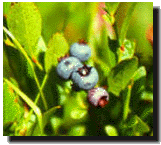
There is no doubt that our fertile soil and temperate climate translate into ideal growing conditions for many marketable crops. Our rich agricultural land is our greatest natural resource. It is only fitting, then, that economic development strategies build on that wealth to create new opportunities for the Island’s economy. That very spirit has guided provincial and federal government agencies to research and promote the development of new agricultural commodities for Prince Edward Island. These emerging crops include ginseng, industrial hemp, emus, cranberries, and blueberries.
The first crop of ginseng, considered the “herb of all herbs,” was planted in 1987 on a quarter-acre plot. New interest arose again in 1991, when five new growers planted one half acre each. By 1993, there were eight growers with approximately ten acres in production. Traditionally, major markets for ginseng have been Pacific Rim countries and Asian communities in North America, but growing interest in herbal remedies and holistic health are creating new markets here at home. Growing ginseng is a demanding and expensive enterprise that requires a long-term management plan, expensive machinery and equipment, and entails a high level of risk. Nevertheless, it is a profitable crop and Island growers are committed to making it work.
Hemp is an annual plant. It is grown as a fibre crop or for applications including bio-mass fuel, lubricants, medicines, building materials, hemp seed, edible cakes, and textiles. Extremely versatile and high yielding, it is probably the first plant ever cultivated for textile fibre. In 1938, the cultivation of hemp was prohibited under the Opium and Narcotic Drug Act. However, growing awareness of the environmental benefits, high productivity and high quality of hemp, coupled with an acknowledgement of the lack of psychoactive properties in fibre hemp, which has extremely low tetrahydrocannabinol content, unlike its sibling strain, marijuana, has led to the granting of research licences for hemp growers in 1994. As a result of this, in 1998, a Prince Edward Island grower planted the first commercial crop of fibre hemp.
 Wild blueberries are a unique
crop in that the plants are neither planted, cultivated,
nor harvested in the usual way. Rather, lowbush (or wild)
blueberry growers “manage” wild stands of
native plants, most often found growing on old farm land
that has been abandoned for 30 to 50 years. It usually
takes between three and ten years for a blueberry field
to become productive. In 1995, 660 acres of blueberries
were harvested. In 1996, the harvest increased to 1,300
acres and by 2003, it is expected that an additional
6,000 acres will have come into production. The majority
of Prince Edward Island’s blueberry crop is shipped
to processors and used in a number of products varying
from breakfast cereals, muffins, to jams and yogurts, to
wines. Only about one percent of the crop is sold fresh
locally.
Wild blueberries are a unique
crop in that the plants are neither planted, cultivated,
nor harvested in the usual way. Rather, lowbush (or wild)
blueberry growers “manage” wild stands of
native plants, most often found growing on old farm land
that has been abandoned for 30 to 50 years. It usually
takes between three and ten years for a blueberry field
to become productive. In 1995, 660 acres of blueberries
were harvested. In 1996, the harvest increased to 1,300
acres and by 2003, it is expected that an additional
6,000 acres will have come into production. The majority
of Prince Edward Island’s blueberry crop is shipped
to processors and used in a number of products varying
from breakfast cereals, muffins, to jams and yogurts, to
wines. Only about one percent of the crop is sold fresh
locally.
Since the establishment of Prince Edward Island’s first emu farm in 1992, there has been growing interest and involvement in the raising of this flightless bird. Native to Australia, the emu adjusted well to the Island climate and producers quickly learned that the types of land, fencing, housing, and feed needed to raise emus were readily available in the province. The market for emus in Prince Edward Island has primarily been for breeding stock. However, other areas of the world benefit from thriving emu product markets. Their hides are used in high fashion clothing; the meat is a low cholesterol red meat that tastes a bit like beef; oil rendered from emu fat is used in cosmetics; the feathers are used in the fashion industry; and toenails and infertile eggs are used for ornaments and jewelry.
Another commodity, once common on the Island, is increasing in popularity once again: maple syrup. Although Fred Fall (Island Sun) of Hampton and Arnold Madsen (Madsen’s Maple Syrup) of Summerside are commercial maple syrup producers on the Island, at one time families across Prince Edward Island tapped Maple trees as frequently as they baked bread. The maple syrup season runs for approximately one month beginning in the middle of March; with an ideal season punctuated by frosty nights and warm sunny days of +6°C. Led primarily by the eastern region of the country, Canada produces approximately 75 percent of the world’s maple sugar. While Fred Fall uses a more old-fashioned method of drilling a hole into a Maple tree, hanging a pail to collect the sap, and hauling it by tractor to the evaporator house where it is boiled down to make syrup, Arnold Madsen takes the more streamlined approach of using plastic lines to transport the sap. Maple syrup is a particularly desirable product because it is 100 percent pure with no additives. Traditionally served on pancakes, it can be used in a wide variety of ways, from ice cream or porridge topping to baked goods and candy-making. Considering it takes 30–40 gallons of sap to make one gallon of syrup, this product is most often found in small consumer amounts rather than bulk quantities.
Potatoes | Fruits and Vegetables |
Field Crops | Beef and Dairy
Swine | Poultry and Eggs | Beekeeping
